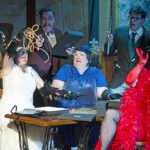Home »

Fascinating tale will keep readers glued to this book
Book Review
By Derryll White
 Asensi, Matilde (2006). The Last Cato.
Asensi, Matilde (2006). The Last Cato.
“I know a Greek labyrinth that is a unique, straight line. SO many philosophers have gotten lost on this line that even a mere detective could get lost.” — Borges
Written in 2001 by Matilde Asensi, of Alicante, Spain, ‘The Last Cato’ wasn’t translated into English until 2006, by Pamela Carmell.
Dr. Ottavia Salina is not your typical sleuth. he is a highly esteemed, strict and driven paleographer in charge of the Vatican’s restoration lab. She is a nun and a daughter of the church, a member of the Order of the Blessed Virgin Mary. She is a bit of a female curiosity in a very strict and male hierarchy. Dr. Salina is assisted in her search, commanded by the Vatican’s highest offices, by Captain Glauser-Röist of the fabled Swiss Guard.
The novel gives early indications of being ‘different’. The authority and structure of the Vatican, and indeed the Catholic nation, is declaimed early. Then quickly the story diverts into scarification and body art. To what purpose the reader isn’t clear, but it is very obvious that stranger things are to come. The author brings to the fore fascinating facts on the early history of Christianity.
The journey from Dante to Jung, through the crypts of both the church and the mind, is fascinating. Dan Brown has nothing on Matilde Asensi. She weaves architecture, alchemy and the mysterious practices of the Christian church into an inspiring tale of mysticism and devotion.
‘The Last Cato’ is also a moving love story, in ways love isn’t thought about much these days. Asensi brings together a lot of threads – Sicilian mafia, Church fanaticism, early civilizations, ideal communities – but she pulls it all off. This is a fascinating tale that will keep the reader glued to the pages.
****
TATTOOING – “Another peculiar piece of information, also irrelevant to our work, is that this practise is becoming fashionable among young men in many countries. They call it ‘body art’ or ‘performance art,’ and one of its most prominent followers is the singer and actor David Bowie.”
“I can’t believe it,…” I sighed, with a slight smile. “Do you mean they let someone cut them like that just to be fashionable?”
“Well…,” he murmured, as disturbed as I. “It has something to do with eroticism and sensuality, but I wouldn’t know how to explain it to you.”
THE BURNING BUSH – Around the 4th century, in 337, Empress Helen, the mother of Emperor Constantine, built a beautiful sanctuary in that valley. From that moment, numerous Christian pilgrims began to journey there. Among these first pilgrims was the famous Galician nun Egeria, who traveled through the Holy Land from the Passover of 381 until the Passover of 384. In her skillfully narrated Itinerarium, Egeria recounted that where the monastery of Saint Catherine of Sinai would later be erected, a group of hermits tended to a small temple whose apse protected the sacred bush, which was still alive back then.
WOMEN – I wasn’t surprised. In general, all religions of the world discriminate against women, either relegating them to a puzzling second class or legitimizing their abuse and mistreatment. It’s really a shame that nobody seems to want to find a solution to it.
THE SECRETS – “The great students of alchemy, such as the psychiatrist Carl Jung, supported the idea that it was a path to self-knowledge, a process of searching for one’s self, that went through the stages of dissolution, coagulation, and sublimation – in other words, the three works or alchemic steps. Perhaps the aspiring staurofilakes had to suffer a process similar to destruction, integration, and perfection. The brotherhood may have gotten its symbolic language from that.”
HISTORY – The wisdom of the past had crossed the centuries hidden in popular customs, stories, children’s games, legends, traditions, and seemingly innocuous books. To find it, we had to change the way we looked at the world. We had to accept that our eyes and ears are poor receptors of the reality that surrounds us. We had to open our minds and put aside preconceived notions.
ISTANBUL – Before, there had been little wooden cabinas with beautiful shutters painted the colors of the rainbow. Now groups of Russians were crowded together to sell trinkets, and young Turks sporting shaggy Islamic beards instead of the traditional Ottoman mustache ate garbanzo beans and pistachios from paper cones. I was shocked at the number of women wearing the turban, the traditional black veil pinned under their chins.
 – Derryll White once wrote books but now chooses to read and write about them. When not reading he writes history for the web at www.basininstitute.org.
– Derryll White once wrote books but now chooses to read and write about them. When not reading he writes history for the web at www.basininstitute.org.








